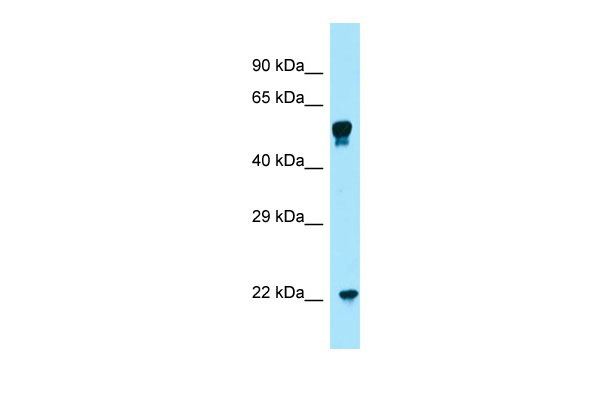COQ7 antibody - C-terminal region
Rabbit Polyclonal Antibody
- SPECIFICATION
- CITATIONS
- PROTOCOLS
- BACKGROUND

Application
| WB |
|---|---|
| Primary Accession | Q99807 |
| Other Accession | NM_001190983, NP_001177912 |
| Reactivity | Human, Mouse, Rat, Rabbit, Horse, Yeast, Bovine, Guinea Pig, Dog |
| Predicted | Human, Mouse, Rat, Rabbit, Pig, Horse, Yeast, Bovine, Guinea Pig, Dog |
| Host | Rabbit |
| Clonality | Polyclonal |
| Calculated MW | 20kDa |
| Gene ID | 10229 |
|---|---|
| Alias Symbol | CAT5, CLK-1, CLK1 |
| Other Names | Ubiquinone biosynthesis protein COQ7 homolog, Coenzyme Q biosynthesis protein 7 homolog, Timing protein clk-1 homolog, COQ7 |
| Format | Liquid. Purified antibody supplied in 1x PBS buffer with 0.09% (w/v) sodium azide and 2% sucrose. |
| Reconstitution & Storage | Add 50 ul of distilled water. Final anti-COQ7 antibody concentration is 1 mg/ml in PBS buffer with 2% sucrose. For longer periods of storage, store at 20°C. Avoid repeat freeze-thaw cycles. |
| Precautions | COQ7 antibody - C-terminal region is for research use only and not for use in diagnostic or therapeutic procedures. |
| Name | COQ7 {ECO:0000255|HAMAP-Rule:MF_03194, ECO:0000312|HGNC:HGNC:2244} |
|---|---|
| Function | Catalyzes the hydroxylation of the 5-methoxy-2-methyl-3-(all- trans-polyprenyl)benzoquinone at the C6 position and participates in the biosynthesis of ubiquinone (Probable). Catalyzes the reaction through a substrate-mediated reduction pathway, whereby NADH shuttles electrons to 5-methoxy-2-methyl-3-(all-trans-decaprenyl)benzoquinone, which then transfers the electrons to the two Fe(3+) centers (PubMed:23445365). The binding of 5-methoxy-2-methyl-3-(all-trans- polyprenyl)benzoquinone (DMQn) mediates reduction of the diiron center by nicotinamide adenine dinucleotide (NADH) and initiates oxygen activation for subsequent DMQ hydroxylation (PubMed:23445365). The physiological substrates are 5-methoxy-2-methyl-3-(all-trans- nonaprenyl)benzoquinone (DMQ(9)) and 5-methoxy-2-methyl-3-(all-trans- decaprenyl)benzoquinone (DMQ(10)), however in vitro the enzyme does not have any specificity concerning the length of the polyprenyl tail, and accepts tails of various lengths with similar efficiency (PubMed:23445365, PubMed:28409910). Also has a structural role in the COQ enzyme complex, stabilizing other COQ polypeptides. Involved in lifespan determination in a ubiquinone-independent manner (By similarity). Plays a role in modulating mitochondrial stress responses, acting in the nucleus, perhaps via regulating gene expression, independent of its characterized mitochondrial function in ubiquinone biosynthesis (PubMed:25961505). |
| Cellular Location | Mitochondrion inner membrane {ECO:0000255|HAMAP- Rule:MF_03194}; Peripheral membrane protein {ECO:0000255|HAMAP- Rule:MF_03194}; Matrix side {ECO:0000255|HAMAP-Rule:MF_03194} Mitochondrion. Nucleus. Chromosome |
| Tissue Location | Expressed dominantly in heart and skeletal muscle. |

Thousands of laboratories across the world have published research that depended on the performance of antibodies from Abcepta to advance their research. Check out links to articles that cite our products in major peer-reviewed journals, organized by research category.
info@abcepta.com, and receive a free "I Love Antibodies" mug.
Provided below are standard protocols that you may find useful for product applications.
References
Asaumi S.,et al.Genomics 58:293-301(1999).
Wiemann S.,et al.Genome Res. 11:422-435(2001).
Ota T.,et al.Nat. Genet. 36:40-45(2004).
Martin J.,et al.Nature 432:988-994(2004).
Mural R.J.,et al.Submitted (JUL-2005) to the EMBL/GenBank/DDBJ databases.
If you have used an Abcepta product and would like to share how it has performed, please click on the "Submit Review" button and provide the requested information. Our staff will examine and post your review and contact you if needed.
If you have any additional inquiries please email technical services at tech@abcepta.com.













 Foundational characteristics of cancer include proliferation, angiogenesis, migration, evasion of apoptosis, and cellular immortality. Find key markers for these cellular processes and antibodies to detect them.
Foundational characteristics of cancer include proliferation, angiogenesis, migration, evasion of apoptosis, and cellular immortality. Find key markers for these cellular processes and antibodies to detect them. The SUMOplot™ Analysis Program predicts and scores sumoylation sites in your protein. SUMOylation is a post-translational modification involved in various cellular processes, such as nuclear-cytosolic transport, transcriptional regulation, apoptosis, protein stability, response to stress, and progression through the cell cycle.
The SUMOplot™ Analysis Program predicts and scores sumoylation sites in your protein. SUMOylation is a post-translational modification involved in various cellular processes, such as nuclear-cytosolic transport, transcriptional regulation, apoptosis, protein stability, response to stress, and progression through the cell cycle. The Autophagy Receptor Motif Plotter predicts and scores autophagy receptor binding sites in your protein. Identifying proteins connected to this pathway is critical to understanding the role of autophagy in physiological as well as pathological processes such as development, differentiation, neurodegenerative diseases, stress, infection, and cancer.
The Autophagy Receptor Motif Plotter predicts and scores autophagy receptor binding sites in your protein. Identifying proteins connected to this pathway is critical to understanding the role of autophagy in physiological as well as pathological processes such as development, differentiation, neurodegenerative diseases, stress, infection, and cancer.


